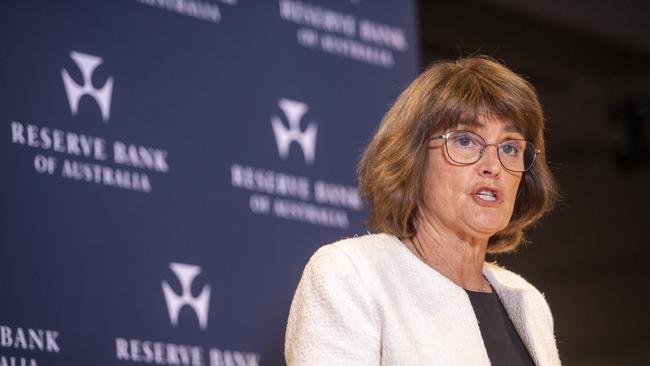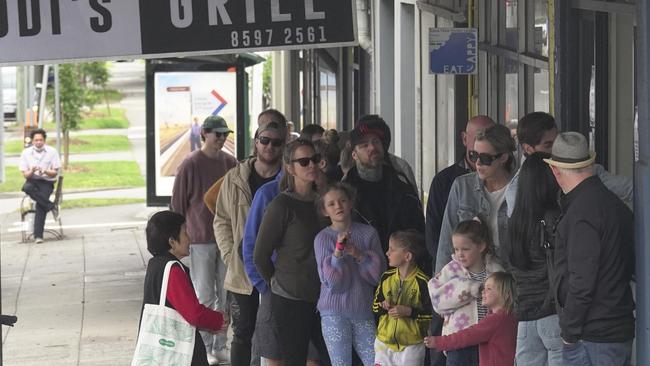Households still paying for the RBA’s inaction after Covid, report
The RBA’s slow response to the post-Covid economic boom is to blame for Australians paying more on their mortgage today, a consulting firm has found.
Interest Rates
Don't miss out on the headlines from Interest Rates. Followed categories will be added to My News.
The Reserve Bank failed to act quickly enough when Australia’s inflation rate spiked at the end of the pandemic, which is a mistake mortgage holders are still paying for two years later.
According to the KPMG Inflation Pressure Gauge, a slow-moving RBA, led by then governor Philip Lowe, failed to remove excess demand from the system.
According to the research, Aussies demand skyrocketed post-Covid due to big spending packages by the then Coalition government under Scott Morrison, including JobKeeper and Home Builder.
Typically, when inflation is driven by excess demand, central banks can raise interest rates to reduce consumer spending, business investment and borrowing, which in theory should cool the economy and bring inflation back within the RBA’s target band of 2-3 per cent.
KPMG found Mr Lowe’s failure to act led to higher demand factors which contributed an average of 1.8 percentage points towards annual headline inflation during the period between June quarter 2021 and March quarter 2022.
KPMG chief economist Brendan Rynne said the overstimulation in the economy through excessively accommodative fiscal and monetary policy, which Aussies are still paying for today.
“If the RBA had acted sooner and raised the cash rate in early-to-mid 2021 the Australian economy would have likely experienced a quicker return of inflation to target levels, thereby lessening the financial burdens currently being experienced by consumers and businesses,” he said.


“Further, by tightening monetary policy sooner – justified through the rise in demand-driven inflation – the RBA would now be in a position to start lowering the cash rate, thereby supporting the current weak levels of economic growth.”
The call comes as the RBA kept rates on hold following its December meeting.
The Reserve Bank has held the official cash rate at 4.35 per cent, flagging Australia’s trimmed mean inflation remains above its target range of 2 to 3 per cent.
RBA governor Michele Bullock revealed the central bank board did not “explicitly” consider an interest rate cut, or a hike, at its December meeting.
The board said underlying inflation remained “too high” at 3.5 per cent and noted it was not expected to return to the midpoint of 2.5 per cent until 2026.
“The board wanted to give the message that they have noticed some of the data is a bit softer,” she said.
“We’re not saying that we’ve won the battle against inflation yet but we’re saying that we have a little bit more confidence that things are evolving as we think in our forecast.”
4 in 10 households now struggling
With Aussies now living with higher for longer interest rates, separate research shows 40 per cent of households are now unprepared for higher rates in 2025, should the central bank hold interest rates for the foreseeable future.
A new survey of more than 2000 Australians by Canstar.com.au reveals that people with an owner-occupier mortgage, only 60 per cent feel financially prepared for interest rates to remain elevated into 2025.
Of the 40 per cent who are unsure if they have the funds to keep paying their mortgage, only 16 per cent said they would sell their property.
This is becoming increasingly likely with stronger than expected job figures in November leading the cash markets to factor in just a 40 per cent chance of a rate cut in February.
According to Canstar the majority of Aussies will look to cut back on living expenses even further, draw from other investments or ask friends and family for help.
Canstar data insights director Sally Tindall said this year had been incredibly tough for households especially for those who had little savings to begin with.

“While there has been a small amount of relief from the stage three tax cuts and government electricity rebates, for many families that extra cash has barely touched the sides,” she said.
Ms Tindall said households could spend half a day haggling or switching each of your recurring bills – the mortgage, electricity and gas, home internet, and mobile phone.
“If you don’t have enough petrol in the tank to make it through the majority of 2025 without a rate cut, work on a plan to inject more fuel into your budget over summer,” she said.
“If this isn’t enough to get your budget over the line, work out exactly what your plan B might be.
“Selling investments, moving house, even applying for hardship with your bank might serve as effective circuit breakers, but they each require careful consideration.”
Originally published as Households still paying for the RBA’s inaction after Covid, report



